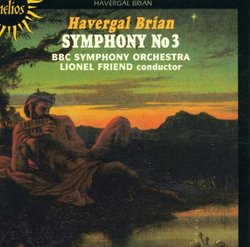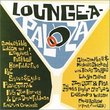| All Artists: Havergal Brian, Lionel Friend, Andrew Ball, Julian Jacobson Title: Brian: Symphony No. 3 Members Wishing: 0 Total Copies: 0 Label: Hyperion UK Release Date: 10/12/1999 Album Type: Import Genre: Classical Style: Symphonies Number of Discs: 1 SwapaCD Credits: 1 UPC: 034571150291 |
Search - Havergal Brian, Lionel Friend, Andrew Ball :: Brian: Symphony No. 3
CD DetailsSimilar CDs |
CD ReviewsHighly involving music - a must for any lover of large scale MartinP | Nijmegen, The Netherlands | 07/30/2005 (5 out of 5 stars) "Havergal Brian is one of those composers that far more people have heard of than have actually heard anything by him. His claim to fame is his gargantuan First Symphony, the Gothic, which got him into the Guiness book of Records as the composer of the largest symphony ever. But there is much more to Brian than megalomania - anyone who has ever in fact heard the Gothic can attest to that. Self-taught, he composed works of great individuality, that may be faintly reminiscent of others at times (Vaughan Williams, Elgar, R. Strauss, Mahler spring to mind), but in the end always retain their own unique voice. The Third symphony (written in the 1930's) shares with its more notorious predecessor an atmosphere of wild invention and brilliant use of large orchestral forces. For though it is not nearly as enormous as the First, the Third is by no means a bagatelle: it involves quadruple woodwinds, an army of brass and percussion, two grand pianos and an organ, among others, and lasts a full hour. Yet it is also more tightly constructed and of a piece than the Gothic. Wayward, and even bizarre, as Brian's invention may seem at times, he knows where he is going, and in the 20 minute first movement in fact offers us a richly varied, but nonetheless classically constructed sonata form. The Scherzo is even more traditional - in form that is, for its music vacillates between a military band gone haywire and a dipsomaniac's version of a Bruckner Ländler. But no matter what he does - it is involving and fascinating throughout. This is one of those pieces that are such a sheer joy to listen to that an hour passes as if it were a mere few minutes. Extraordinary orchestral effects, such as the dialogue between two piano's and two timpanists in the first movement, vie for attention with passages of truly dumbfounding beauty, such as the coda of the second movement. Moments glittering with celesta, harps and pianos give way to quiet meditations, or even to a Vaughan-Williamslike lark ascending, that are in turn subsumed by dark, ominous marches. This makes for extremely rewarding listening. Helpfully, the 4 movements are broken up into 21 tracks, and David Brown patiently guides you through them in his excellent booklet notes. Finally, I find it impossible to fault the playing of the BBC SO, which is inspired to say the least; or the recording, which is rich, detailed and quite spectacular in climaxes (be it that the ad lib organ is not particularly audible). At the Helios price, this is extremely recommendable." Interesting Sungu Okan | Istanbul, Istanbul Turkey | 10/25/2003 (5 out of 5 stars) "Havergal Brian is not too known a English composer, he was lived very long, and he written 32 symphonies.His most knwon works are: Symphony No. 1 "Gothic", 3 and 4 "Das Siegeslied"...As you know, his "Gothic Symphony" to be recorded in Guiness Records (with the most large orchestra ever used in music)And this symphony, also, written for large orchestra: quadruple winds, 8 horns, 4 trumpets, 4 trombones, 2 tubas, 2 set timpani, 3 side drums, cymbals, bass drum, gong, bells, 2 pianos, 2 harps, organ (may be ommited, but used in this CD), and about 60 strings...Havergal Brian is a post-romantic composer, like another important English composer Robert Simpson. So, Brian wasn't used atonality or 12-tone system, like his contemporary Schoenberg, Stravinsky, Penderecki, Varese...But, still, he wasn't written tonal music at all. He move around tonality between atonality borders...Especially, he was liked that composing for large ensembles. After, Symphony No. 6 "Sinfonia tragica", he written not too long, usually mid-length works. (about 20 minutes etc.)And this recording is a good choice to beginning his music and performers are very good.Recommended."
|




